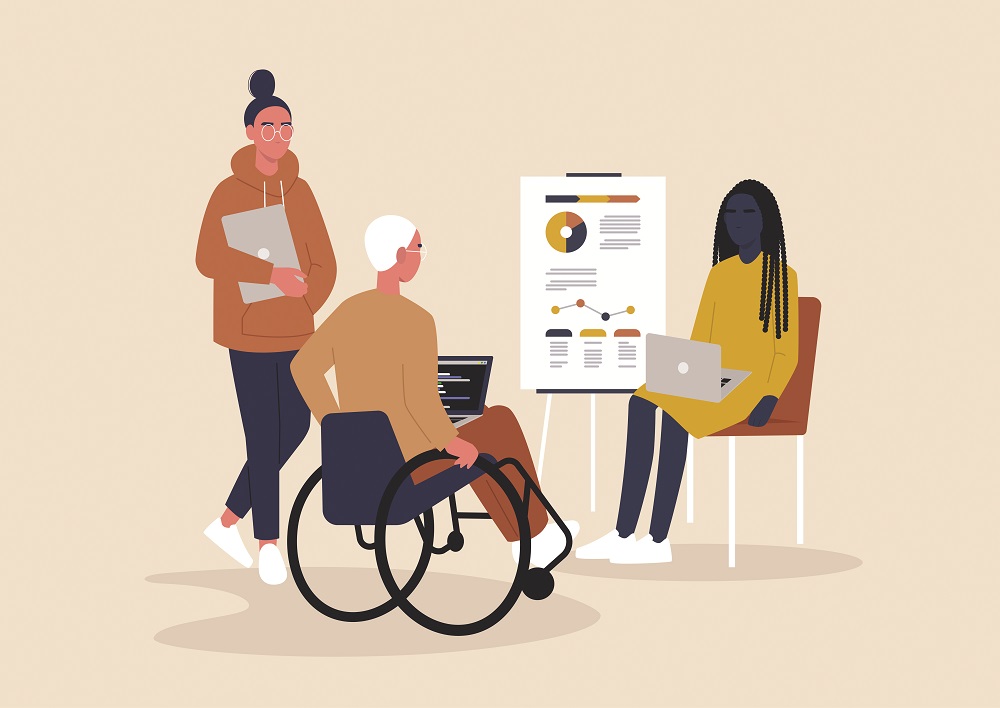In a three-part series on women in the commercial AV industry, we delved into the achievements of women who have broken barriers and commanded the table as directors, as CEOs and in other executive positions. We witnessed women soaring to great heights, while still taking time to mentor young, up-and-coming females in our industry. These leaders we highlighted have undoubtedly helped pave the way for others’ future successes.
Throughout this series, virtually every interviewee underlined the importance of creating a culture of inclusivity and equity…a culture within which women and others from marginalized communities can be seen and heard. Several groups have arisen in our industry in recent years that are leading the effort to inspire companies and individuals within commercial AV to embrace diversity, equity and inclusion (DEI). These groups include the AVIXA Diversity Council and the NSCA DEI Action Council. Those initiatives notwithstanding, however, there’s still a long way to go before our industry truly embodies inclusivity.
Related: Earning A Seat at The Table
CI spoke with two of AVIXA’s powerhouse women, Joé Lloyd and Sarah Joyce, and we reached out to Shen Milsom & Wilke (SMW)’s Jenn Steinhardt and LyncVerse Technologies’ Shameka Dunbar for their perspectives on these issues. In this feature, we will explore the efforts and achievements of these commercial AV industry leaders. Moreover, CI will espouse the importance of inculcating DEI and embracing people of different backgrounds and identities, both within and outside of the office.
Defining ‘Culture’
In recent months, we’ve witnessed ongoing discussions of how to incorporate diversity and inclusivity within commercial AV companies. In those discussions, the term “company culture” rose to prominence. Several HR departments also pride themselves on fostering a great company culture for their current and prospective employees, but what does “culture” mean in the AV industry? For Lloyd, senior director of communications at AVIXA, the foundation of culture is “creating an environment of belonging.”
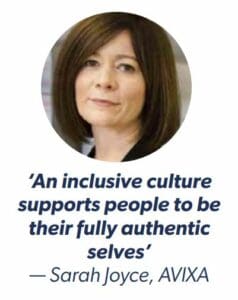 Part of fostering a culture of belonging is cultivating a willingness to embrace other perspectives, cultural traditions and life experiences. When employees step into the shoes of their peers, they expose themselves to new and different experiences. This, then, builds a more tight-knit community. During our conversation, Lloyd mentions, “…[P]eople from multicultural backgrounds — especially women — often [have to] adapt their meeting schedules during religious celebrations. When all employees are aware of such challenges, they can address them.”
Part of fostering a culture of belonging is cultivating a willingness to embrace other perspectives, cultural traditions and life experiences. When employees step into the shoes of their peers, they expose themselves to new and different experiences. This, then, builds a more tight-knit community. During our conversation, Lloyd mentions, “…[P]eople from multicultural backgrounds — especially women — often [have to] adapt their meeting schedules during religious celebrations. When all employees are aware of such challenges, they can address them.”
In that vein, Lloyd points to a project that involves celebrating Ramadan and Passover in the office kitchen with all employees — not just those practicing those respective faiths. In so doing, employees foster that sense of community.
Joyce, chief global officer at AVIXA, defines culture from her perspective. She remarks, “An inclusive culture supports people to be their fully authentic selves.” While discussing the multifaceted nature of her position, she describes her efforts in this regard. She says, “My passion is building a culture of inclusion in organizations and companies [worldwide]. We all represent the society we live in and work in. Therefore, the onus is on the organization to recognize the breadth of society and the opportunities [that entails].”
Joyce notes that the AV workforce is constantly looking for innovations and embracing opportunities. Our industry would do well to harness that spirit of vibrancy, she argues. Joyce says, “This leads to innovation, which leads to openness. [And that] lends itself to an inclusive culture.”
Weaving together Lloyd and Joyce’s insights, fostering a good company culture is about creating a platform that acknowledges the various backgrounds of every individual within the organization, while also ensuring that diverse opportunities are available to all.
Creating an Inclusive Culture
Steinhardt, AV design associate at SMW, has always been an advocate for fostering an inclusive culture. Drawing from her own experiences with sensory processing disorder and neurodiversity, Steinhardt explains, “It can often be challenging and scary to speak up in an environment that does not provide the safe space to do so.”
Dunbar, director of AV services at LyncVerse Technologies, adds that an organization must have a strategy in place if it’s going to have an inclusive, safe company culture. “It’s one thing to say ‘I support so and so from this background,’” she explains. “However, there has to be a strategy behind the words being said.” Effectuating that strategy, Dunbar says, will drive our industry to greater heights by enabling us to capitalize on the talent we have within our organizations.
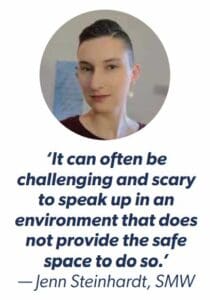 This leads to the issue of attracting and recruiting that very talent in the first place. For many years, the commercial AV industry has struggled with recruitment — especially with diverse recruitment. Our industry continues to miss out on richly diverse talent simply due to this lack of awareness. Drawing on her own experiences, Dunbar explains, “…[W]omen like me were not even aware of the AV work we were doing [back then].” She expresses her wish to see AV-related curriculum brought to the forefront in schools and for STEM majors. That, Dunbar says, “…will enable more women to be more successful in the industry.” She credits the AVIXA Women’s Council and the AVIXA Diversity Council, both of which advocate for awareness of AV and implementation of DEI strategies, for driving welcome changes.
This leads to the issue of attracting and recruiting that very talent in the first place. For many years, the commercial AV industry has struggled with recruitment — especially with diverse recruitment. Our industry continues to miss out on richly diverse talent simply due to this lack of awareness. Drawing on her own experiences, Dunbar explains, “…[W]omen like me were not even aware of the AV work we were doing [back then].” She expresses her wish to see AV-related curriculum brought to the forefront in schools and for STEM majors. That, Dunbar says, “…will enable more women to be more successful in the industry.” She credits the AVIXA Women’s Council and the AVIXA Diversity Council, both of which advocate for awareness of AV and implementation of DEI strategies, for driving welcome changes.
Joyce picks up on the Diversity Council’s efforts, bringing up initiatives such as the “Industry Pledge” (also an AVIXA initiative) and the online “AV Meets Food” events. What’s more, she cites the Women’s Council in India as a prime example of women supporting each other in inclusive safe spaces where CTS study groups emerged as great successes.
According to Joyce, these efforts serve multiple purposes — from familiarizing people with unconscious bias and educating people about neurodiversity as a competitive advantage for your company, to developing materials for websites to make them more inclusive and accessible.
Related: AVIXA Increases Emphasis on Diversity, Equity and Inclusion with Pledge, Toolkit
“We provide webinars and training programs, along with virtual roundtables,” Joyce explains. “We also provide tools to organizations and companies [so they can] be more LGBTQ+ inclusive….” This, she says, includes helping people understand the importance of people’s pronouns and offering tutorials on how to write inclusive job descriptions.
When CI asks why it’s paramount to implement all these tools and strategies, Joyce points to research from Harvard Business School and McKinsey that shows how recognizing DEI initiatives and emphasizing belonging are key to increasing a company’s bottom line.
“There’s a clear correlation between gender and ethnic diversity and profitability,” she cites. “The ‘Delivering through Diversity’ report from McKinsey in 2019 shows that companies in the top quartile for gender diversity on executive teams were 25% more likely to have above-average profitability than peer companies in the fourth quartile. And, for ethnic diversity, it was 36% more profitable.”
The Pandemic Acceleration
In the last few years, the AV industry has certainly become much more active in initiating and enacting DEI initiatives. One question to consider is whether the COVID-19 pandemic accelerated those efforts. According to our interviewees, pandemic circumstances perhaps served to level the playing field for many women and people with disabilities.
Steinhardt brings up that the pandemic led to virtual networking opportunities that otherwise wouldn’t have existed. “When Chris Neto did his #AVHappyHours, I got the opportunity to interact with friends I had made on Twitter,” she says. Comparing these events favorably to the sensory overload she experiences in a bar, Steinhardt adds, “Particularly for myself, with ADHD, autism and sensory processing, I could turn off my camera and still engage with people. These kinds of engagements, in that environment, were so unique.” Steinhardt acknowledges that, had the pandemic not happened, meeting industry peers on that scale would not have been possible.
Relating to online access as an avenue for diversity and inclusion, Joyce spotlights the recent development whereby CTS exams can be taken with online proctoring. “Now, you don’t have to go to a trade show or testing center to take the exam,” she enthuses. “It is fantastic for those countries where testing locations aren’t plenty.” With online proctoring, Joyce says, international AV professionals who contribute to the global workforce can now earn their certifications remotely.
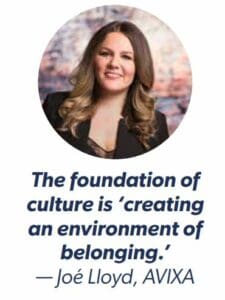 Lloyd highlights another benefit of workplaces adopting videoconferencing technologies — namely, she believes that the hybrid work environment increased meeting equity. “[Things have] changed particularly for us women who work from home,” she says. “Each employee now has the same, equal-size box on screen. [We] have now experienced how to work with [different styles] and learned how to accommodate and give voice to each style. Each of us are equal note takers, contributors and next-step takers.”
Lloyd highlights another benefit of workplaces adopting videoconferencing technologies — namely, she believes that the hybrid work environment increased meeting equity. “[Things have] changed particularly for us women who work from home,” she says. “Each employee now has the same, equal-size box on screen. [We] have now experienced how to work with [different styles] and learned how to accommodate and give voice to each style. Each of us are equal note takers, contributors and next-step takers.”
However, other, less positive workforce developments also arose during the pandemic. One concerning issue is the statistical indication of women leaving the workforce at a faster rate than men are. Lloyd reveals that Black women, in particular, are actually leaving in considerably higher percentages, as a result of increased burnout and microaggressions faced at work.
To combat this, Dunbar underlines the importance of bringing male members of the workforce into the conversation. She stresses that, across industry councils, men must take a stand alongside women.
Men, Dunbar adds, must listen and must seek to understand the challenges that women and other under-represented groups face. She remarks, “If you don’t bring men to bridge that gap, there is no possible way to move forward.”
Small But Effective Strides
We’re all familiar with the adage “Rome was not built in a day.” The same goes for our industry and its efforts to achieve DEI. Yet, every small step counts, as each is a stride toward the vision that these powerful women have set forth.
For Steinhardt, one of those small steps involved speaking publicly about her autism diagnosis on Twitter. “As I started researching, I reached out on the Twitterverse and asked if people knew any resources. I actually got direct and public responses that guided me through the process. I give full credit to #avtweeps for opening their arms and being so understanding,” she expresses. Steinhardt adds that people simply askin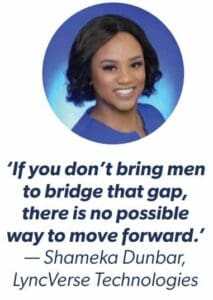 g her if she would prefer verbal or written communication highlights the level of support she receives from within the industry.
g her if she would prefer verbal or written communication highlights the level of support she receives from within the industry.
Joyce, meanwhile, mentions changes to the office environment as small, incremental means of achieving DEI goals. Those adaptations might include additional training on recognizing unconscious bias, greater emphasis on wellness and other small steps. Together, they build a space of comfort and belonging.
Dunbar sums up the fundamental imperative from her perspective — to establish relationships and build out a support network. “There are tons of resources out there,” she says. “You don’t have to do it all alone; you have people to leverage. And speaking with them might give you [a better] idea of availing those opportunities for yourself.”
Echoing this idea, Lloyd details the number of people and companies who signed AVIXA’s AV Industry Pledge for an Equitable Future. “We have around 1,700 people and around 150 corporate signatures,” she says. “There is room for improvement [in AV], and these signatures show that there is an opportunity and desire to keep acting on it.” Lloyd adds, “Our mission here is to be a virtual diversity officer. We ask our pledges to participate in surveys, webinars and programs, and we will use that data to encourage even greater growth.”
Tying together this entire series and the “table” motif, Joyce states that women do, indeed, need a seat at the table. However, it is equally important to ensure that the room welcomes them. She concludes, “Equity and inclusion are all about creating space for everybody. It’s about recognizing what organizations need to do to ensure they are inclusive and how we all work to deliver that.”

